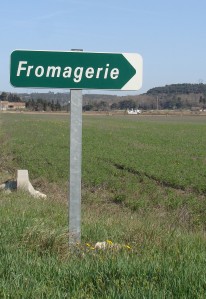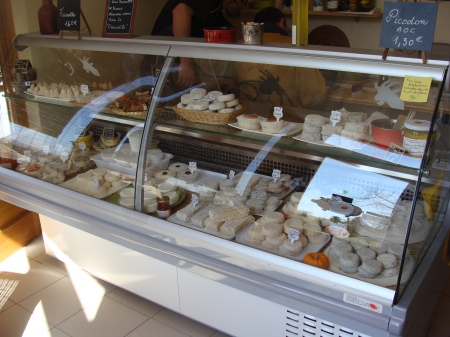
Goat’s cheese that ‘Piques’
March 29, 2010During a dinner with guests this weekend the subject of conversation turned to food as it often does during a French meal -goat’s cheese to be precise. We share the same enjoyment of Picodon, a goat’s cheese made primarily in the departments of the Ardèche and the Drôme. Our friends live in the Drôme and we live in the Ardèche. The two departments go way back in rivalry but our talk did not lend itself to an argument over who makes the best cheese – which can also occur in friendly French dinner conversations. Although we have our favorite producers in the Ardèche, Xavier mentioned that they had been to a local producer of fromage de chèvre last week- one I’ve visited and love as well. He reminded me that now, spring, is the best time to buy goat’s cheese. The highly fragranced cheese is ripest in the spring for two reasons. Typically goats feed on sparse grass and brush in rocky mountainous regions, a landscape typical to both departments. In spring however, the goats are being nourished by the greenest grass of the year having just come out of the most humid season, winter. Secondly, it’s the season of reproduction and the goat’s milk is especially nutrient rich in the first months after the babies are born.
 With goat’s cheese on my mind, this morning when Raphael asked me to run some wine and soil samples to the wine university of Suze la Rousse for testing I found myself with the perfect excuse to stop at the Fromagerie Gerfand. Frequently the best way to find a good cheese is just by stumbling upon a tiny family run farm on a back road in Provence. The Fromagerie Gerfand is en route to the village of La Garde Adhémar in the Drôme. There are no large signs advertising the tiny boutique. One could easily miss the hand painted sign off the main road announcing vente à la Ferme, a farm shop selling fromage de chèvre, Picodon, and other local products.
With goat’s cheese on my mind, this morning when Raphael asked me to run some wine and soil samples to the wine university of Suze la Rousse for testing I found myself with the perfect excuse to stop at the Fromagerie Gerfand. Frequently the best way to find a good cheese is just by stumbling upon a tiny family run farm on a back road in Provence. The Fromagerie Gerfand is en route to the village of La Garde Adhémar in the Drôme. There are no large signs advertising the tiny boutique. One could easily miss the hand painted sign off the main road announcing vente à la Ferme, a farm shop selling fromage de chèvre, Picodon, and other local products.
I turned right at the next road and was relieved to see a more formal sign marked fromagerie. The narrow, unpaved road only allows one car access in either direction at a time. It is lined by blossoming almond trees and an expanse of vibrant green fields conjuring images of Ireland. As I neared the farm the land became wooded and rocky, typical terrain for goats. With my windows open I drove along to the music of bells and bleating. I smelled the animals before I saw them; a parade of goats leaving the barn and running towards the fields. I pulled in front of the small shop and was greeted by a barking dog, definitely a farm dog with his matted and muddy white hair. Could this be how people perceive my children I wondered, after they’ve spent the day roaming the winery, climbing tree and having mud pie battles as they did last Sunday? The bark was for show apparently, as the friendly dog trotted up to the car, tail wagging as I opened the door. He was rewarded with a scratch behind the ears.
There were probably 20 different kinds of goat’s cheese on display in the boutique. Everything from fresh creamy goat’s cheese, one of my favorites to spread on crunchy bread, to the aged Picodon, hard and crumbly with its green tinge and spicy bite. There were bouchons, named after wine cork for their shape, fromage de chèvre à la figue, with pâte de coings (quince paste), swimming in olive oil and herbes de Provence, covered in pepper corns and wrapped in leaves. Not to forget the Picodon’s all in varying degrees of aging.
Once the cheese of peasants, Picodon has become one of the most popular goats cheeses in France and is seen on the tables of the best restaurants in Provence and surrounding regions. The name comes from local dialect and means to pique. Best translated, pique means spicy or having a bite. It holds the label AOC, or Appellation d’origine contrôlée, which means that a product is protected by standards authentic to a certain region. The AOC label is a guarantee of the product’s quality, its location, and the artisanal knowledge, usually passed down through generations of family, of the producer. A goat’s cheese must be aged at least 14 days before it is considered a Picodon.
As I chose my cheese, I watched the production through the small window in the rear of the store. Two woman and a man were busy ladling liquid cheese into faisselle pots, small plastic molds with holes in the bottom where Picodon is aged. I chose 4 cheeses; one the oldest Picodon, for Raphael. I’m sure it piques quite nicely. Unfortunately, I will not be able to enjoy the spicy fromage de chèvre for a few more months. It is unpasteurized and not permitted while pregnant.
Recipe: Tarte au Picodon et aux épinards Spinach Tarte
Either buy or make a tarte pastry. Recipe for pastry follows:
1/4 cup butter
a pinch of salt
3 soup spoons of olive oil
3 soup spoons of water
Mix ingredients mold into a ball. Let sit at room temperature for two hours. Then shape the ball into the bottom and sides of a tarte pan and pre cook for 15 minutes.
2 and a half pounds spinach leaves
4 young Picodons or creamy goats cheese
3 egg yolks
1/2 cup crème fraîche/heavy cream
1 tsp. grated nutmeg
pinch salt and pepper
The day before, boil or steam the spinach leaves. Drain and let sit overnight. The allows for evaporation of most of the water. Otherwise, the mixture is too liquid and the pastry doesn’t become crispy. Spread the spinach on the bottom of the pasty. Mix the eggs, cream, nutmeg, salt and pepper in a bowl and pour over spinach. Cut the cheese in the strips or cubes and disperse over mixture. Cook for 20 to 30 minutes at 380°F.












Can you take me next time? Please?
I actually thought about going back and getting you some to bring over today but then, well, kids….
Ps – How about a wine and cheese night when you feel once the baby has arrived and is weaned?
I’m dreaming of a cheese, wine and bread party. Weaned, Justine, I really feel like a cow now? Ha ha.
Well its raining all day here in Norfolk so your post transported me back to France and you painted a delightful picture of your life style. We are having a cheese renaissance in Britain with lots of craft cheese makers springing up all over the place, local food for local people, and long may it expand and continue. It will never be the same as France but it is moving in the right direction.
That was yesterday. It rained most of the day here too. I’d love to explore the local food of Britain some day, especially the cheese.
This is one of our best local farm shops to give you an idea of what is happening.
http://www.walsinghamfarmsshop.co.uk/
Just found your blogg and it is very interesting and well written, I am so enjoying reading your past stories. thanks.
Thanks for the lovely comments.
Just found your blog and, as a lover of goat’s cheese, I had to stop by and read. Thanks for this little pleasure!
[…] first big find was on my way home after buying goats cheese. Spying a flash of purple, I pulled the car over, hoped out and filled my coat pockets […]
[…] Well, if it’s Goats Cheese that you’re after, you could far worse than try some Goats Cheese that ‘Piques’. […]